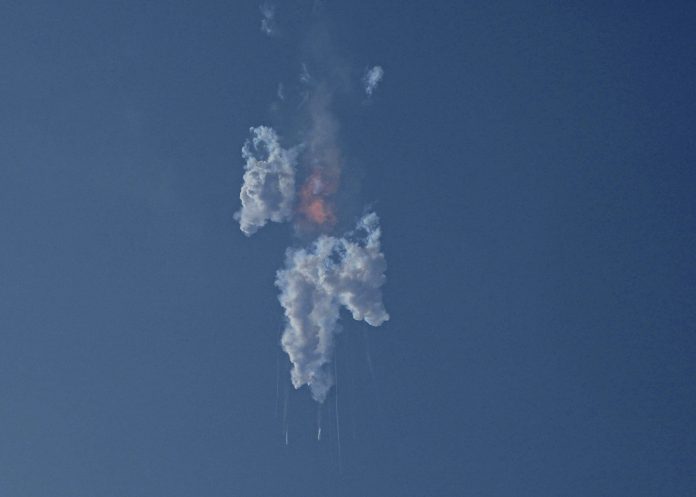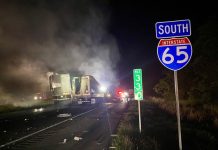
By AIM MEDIA Texas
For The Republic
SpaceX is counting this morning’s first ever launch of Starship-Super Heavy from Boca Chica/Starbase as a success, even though the flight came to an “exciting end” in the words of a SpaceX commentator 3 minutes and 59 seconds after launch.
After a brief pause in the countdown, the 33 engines of the Super Heavy booster rocket ignited shortly after 8:30 a.m., creating a massive plume of dust and fire as the nearly 400-foot tall spacecraft successfully cleared the launch tower.
The vehicle attained a speed of more than 1,340 mph and an altitude of more than 23 miles, and the craft executed the necessary flip for stage separation, which failed to occur.
Ground cameras showed the still-stacked vehicle rotating oddly at 3 minutes into the flight, separation still hadn’t occurred at 3:30 into the flight.
“We saw the start of the flip, but obviously, we’re seeing from the ground cameras the entire Starship stack continuing to rotate,” reported SpaceX principal integration engineer. “We should have had separation by now. Obviously this does not appear a nominal situation.”
At 3:59 into the flight, Starship-Super Heavy exploded over the Gulf, possibly the result of the onboard flight termination system doing its job.
Nonetheless, Kate Tice, SpaceX quality systems engineer, characterized the first Starship orbital test as a success.
“Everything after clearing the tower was icing on the cake,” she said.
SpaceX founder and CEO Elon Musk had put the chances of reaching orbit with the first test at more than 50 percent.
“Congrats SpaceX team on an exciting test launch of Starship!” he tweeted after the flight. “Learned a lot for next test launch in a few months.”
For more, see Friday’s Republic.
From the Associated Press
SOUTH PADRE ISLAND, Texas (AP) — SpaceX’s giant new rocket exploded minutes after blasting off on its first test flight Thursday and crashed into the Gulf of Mexico.
Elon Musk’s company was aiming to send the biggest and most powerful rocket ever built on a round-the-world trip from the southern tip of Texas, near the Mexican border. The nearly 400-foot (120-meter) Starship carried no people or satellites.
Images showed several of the 33 main engines were not firing as Starship climbed from the launch pad, reaching as high as 24 miles (39 kilometers). There was no immediate word from SpaceX on how many engines failed to ignite or shut down prematurely.
The booster was supposed to peel away from the spacecraft three minutes after liftoff, but that didn’t happen. Rather, the rocket with the spacecraft still attached began to tumble and then exploded, plummeting into the water.
Instead of a best-case-scenario 1 1/2-hour flight with the spacecraft taking a lap around the world, the whole thing lasted four minutes. It reached a maximum speed of about 1,300 mph (2,100 kph).
Throngs of spectators watched from South Padre Island, several miles away from the Boca Chica Beach launch site, which was off-limits. As Starship lifted off with a thunderous roar, the crowd screamed: “Go, baby, go!”
Musk, in a tweet, called it “an exciting test launch of Starship! Learned a lot for next test launch in a few months.”
In the weeks leading up to the flight, Musk gave 50-50 odds that the spacecraft would reach orbit and not end up in what SpaceX calls a “rapid unscheduled disassembly.” He said not blowing up the launch pad would be a win.
“You never know exactly what’s going to happen,” said SpaceX livestream commentator and engineer John Insprucker. “But as we promised, excitement is guaranteed and Starship gave us a rather spectacular end.”
The company intends to use Starship to send people and cargo to the moon and, eventually, Mars. NASA has reserved a Starship for its next moonwalking team, and rich tourists are already booking lunar flybys.
Despite the abbreviated flight, congratulations poured in from NASA chief Bill Nelson and others in the space industry. Retired Canadian astronaut Chris Hadfield tweeted, “Huge accomplishment, huge lessons, onwards to the next attempt.”
“It fell somewhere between a small step and their hoped-for giant leap, but it still represents significant progress toward a reusable super-heavy lift rocket,” University of Chicago’s Jordan Bimm, a space historian, said in an email.
At 394 feet and nearly 17 million pounds of thrust, Starship easily surpasses NASA’s moon rockets — past, present and future. NASA successfully launched its new 322-foot (98-meter) moon rocket last November on a test flight, sending the empty Orion capsule around the moon.
The stainless steel Starship rocket is designed to be fully reusable with fast turnaround, dramatically lowering costs, similar to what SpaceX’s smaller Falcon rockets have done soaring from Cape Canaveral, Florida. Nothing was to be saved from this test flight, with the spacecraft — if all had gone well — aiming for a watery grave in the Pacific near Hawaii.
The futuristic spacecraft flew several miles into the air during testing a few years ago, landing successfully only once. But this was to be the inaugural launch of the first-stage booster with 33 methane-fueled engines.
SpaceX has more boosters and spacecraft lined up for more test flight; the next set is almost ready to go. Musk wants to fire them off in quick succession, so he can start using Starships to launch satellites into low-Earth orbit and then put people on board.
It was the second launch attempt. Monday’s try was scrapped by a frozen booster valve.
Jason and Lisa Flores drove down from Corpus Christi to watch the launch with their daughter, and noticed something was amiss.
Lisa Flores cried seeing the liftoff and then realized, “It’s not working out the way it was supposed to.”
Elizabeth Trujillo, 13, wearing a “Star Wars” shirt and carrying toy binoculars, skipped school to see the launch from the beach with her mother and other relatives. The crowd cheered when Starship cleared the tower.
Despite the failed attempt, “it was worth it,” said Jessica Trujillo, Elizabeth’s mother. “Just hearing and seeing the view, the excitement of the crowd, it was priceless.”
“Practice makes perfect. They just got to practice some more,” she added.
___
AP reporter Valerie Gonzalez contributed.




